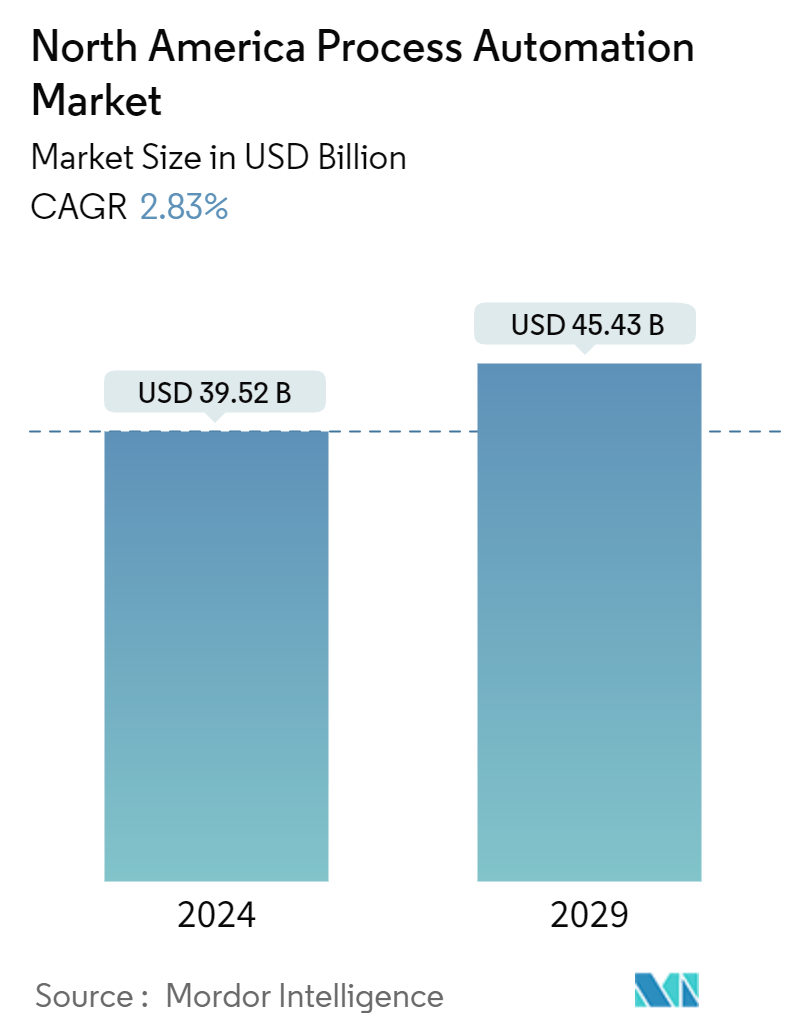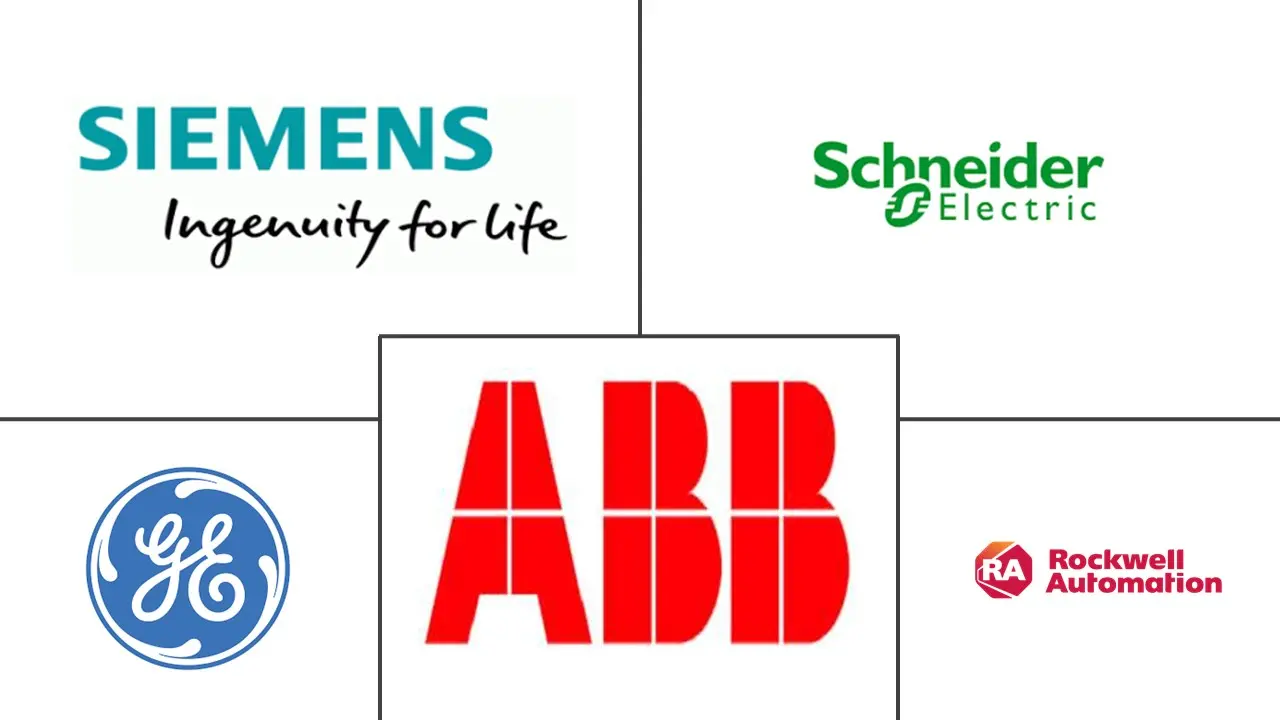Market Size of North America Process Automation Industry

| Study Period | 2019 - 2029 |
| Base Year For Estimation | 2023 |
| Market Size (2024) | USD 39.52 Billion |
| Market Size (2029) | USD 45.43 Billion |
| CAGR (2024 - 2029) | 2.83 % |
| Market Concentration | Low |
Major Players
*Disclaimer: Major Players sorted in no particular order |
North America Process Automation Market Analysis
The North America Process Automation Market size is estimated at USD 39.52 billion in 2024, and is expected to reach USD 45.43 billion by 2029, growing at a CAGR of 2.83% during the forecast period (2024-2029).
Process automation leverages technology to streamline intricate business processes. It generally encompasses three essential functions: process automation, information centralization, and minimizing the need for human intervention. Its primary objective is to eliminate bottlenecks and and minimize errors and data loss while enhancing transparency, communication between departments, and processing speed. Growing technological advancements and a increasing focus on productivity fuel the market for process automation.
- Process automation has become a a method that enhances a system's efficiency by eliminating human involvement. This results in reduced errors, an acceleration in delivery speed, an improvement in quality, a decrease in costs, and a simplification of the overall business process. It involves utilizing software tools, individuals, and procedures to establish a fully automated workflow. By employing process mining, it optimizes the effectiveness of business operations. This enables the acquisition of valuable insights into the user's digital solutions and facilitates the identification of areas where efforts can be applied for maximum advantage. The increasing adoption of automated technologies across the region's various sectors is expected to drive the market.
- The growth of the process automation market is driven by the rising emphasis on boosting productivity and reducing hazardous manual activities. North America, being a well-established market, presents an excellent opportunity for embracing cutting-edge technologies, establishing key alliances, and fostering product synergies in sectors like power and utilities, oil and gas, pharmaceuticals, and chemicals. These elements play a crucial role in propelling the expansion of the process automation market.
- Integrating digital and physical elements in manufacturing has transformed the North American automation industry. The primary goal of these advancements is to achieve optimal efficiency. Automating manufacturing processes has realized numerous advantages, including seamless monitoring, waste reduction, and accelerated production rates. Automation enhances product quality for consumers and ensures standardized, reliable goods are delivered quickly and affordably. The Industrial Internet of Things and Industry 4.0 represent cutting-edge technological strategies reshaping the development, production, and oversight of the logistics network, poised to propel market growth.
- The market's growth is growing due to the increasing adoption of robotic process automation by organizations aiming to improve digital consumer experience, productivity, and efficiency. This growth is further fueled by the integration of AI and machine learning in robotic process automation, facilitating the automation of intricate tasks. Industries such as pharmaceuticals, Oil and Gas, , and F&B are notably embracing robotic technology in the region to boost the market's potential.
- For instance, the pharmaceutical industry in the United States is thriving, making it one of the largest markets globally. Thanks to advancements in automation technology, pharmaceutical companies can now enhance the efficiency and precision of their operations, including filling, packaging, and inspection processes. These automated systems are highly accurate and eliminate the risk of human errors in crucial tasks like weighing, blending, and packaging pharmaceutical products. As a result, the region's pharmaceutical sector is witnessing a surge in investments, which is anticipated to create numerous market opportunities.
- The substantial expenses associated with process automation systems are linked to reliable and durable hardware and streamlined software. Implementing process automation necessitates significant financial investments to enhance the entire infrastructure, encompassing IT, machinery, and more. Additionally, it demands ongoing maintenance, which can impede market expansion compared to manual systems.
North America Process Automation Industry Segmentation
Process automation is using software and technologies to automate processes and functions to accomplish defined organizational goals. The North American process automation market is segmented by communication protocol, system type, end-user industry, and country. By communication protocol, the amrket is divided into wired and wireless. By system type, the market is segmented into system hardware, software type, data analytics, and reporting-based software. By end-user industry, the market is segmented into oil and gas, chemical and petrochemical, power and utilities, water and wastewater, food and beverage, paper and pulp, and pharmaceuticals. By country, the market is segmented into the United States and Canada. For each segment, the market sizing and forecasts have been done on the basis of value (in USD).
| By Communication Protocol | |
| Wired | |
| Wireless |
| By System Type | ||||||||||
| ||||||||||
|
| By End-user Industry | |
| Oil and Gas | |
| Chemical and Petrochemical | |
| Power and Utilities | |
| Water and Wastewater | |
| Food and Beverage | |
| Paper and Pulp | |
| Pharmaceutical | |
| Other End-user Industries |
| By Country | |
| United States | |
| Canada |
North America Process Automation Market Size Summary
The North America process automation market is poised for steady growth, driven by the increasing adoption of advanced technologies across various sectors. This market leverages technology to streamline complex business processes, focusing on enhancing efficiency by reducing human intervention, minimizing errors, and improving communication and transparency. The integration of digital and physical elements in manufacturing, along with the adoption of Industry 4.0 and the Industrial Internet of Things, has significantly transformed the automation landscape in the region. These advancements are not only improving operational efficiency but also fostering economic growth by enabling faster production rates, waste reduction, and enhanced product quality. The pharmaceutical, oil and gas, and food and beverage industries are particularly embracing these technologies to boost productivity and streamline operations.
The market's expansion is further supported by substantial investments in infrastructure and technology, as well as strategic partnerships and mergers among key players. Companies are increasingly focusing on integrating artificial intelligence and machine learning with robotic process automation to handle complex tasks, thereby enhancing digital consumer experiences and operational efficiency. However, the high costs associated with implementing and maintaining process automation systems pose challenges to market growth. Despite these challenges, the region's well-established market, coupled with a strong emphasis on productivity and safety, presents significant opportunities for growth. The ongoing efforts to reduce greenhouse gas emissions and improve energy efficiency are also expected to drive demand for automation technologies, particularly in the oil and gas sector.
North America Process Automation Market Size - Table of Contents
-
1. MARKET INSIGHTS
-
1.1 Market Overview
-
1.2 Industry Attractiveness - Porter's Five Forces Analysis
-
1.2.1 Bargaining Power of Suppliers
-
1.2.2 Bargaining Power of Buyers
-
1.2.3 Threat of New Entrants
-
1.2.4 Threat of Substitutes
-
1.2.5 Intensity of Competitive Rivalry
-
-
1.3 Industry Value Chain Analysis
-
1.4 Analysis of the Major Industrial Automation Hubs in the United States and Canada (Hubs Identified Based on the Investor Activity and Expansion Activities Undertaken over the Last Three Years)
-
1.5 Impact of Key Macroeconomic Trends on the Process Automation Industry in North America
-
1.6 Analysis of the Key Themes Identified Based on the Short- and Medium-term Effects of the Pandemic V-shaped Recovery, Mid-range Recovery, and Slump Recovery
-
1.7 US Process Automation Market Base Variable Analysis Based on End-user Performance
-
1.8 Canada Process Automation Market Base Variable Analysis Based on End-user Performance
-
1.9 Impact of Supply-related Challenges and the Role of Market Regulations in Spurring Activity
-
-
2. MARKET SEGMENTATION
-
2.1 By Communication Protocol
-
2.1.1 Wired
-
2.1.2 Wireless
-
-
2.2 By System Type
-
2.2.1 By System Hardware
-
2.2.1.1 Supervisory Control and Data Acquisition System (SCADA)
-
2.2.1.2 Distributed Control System (DCS)
-
2.2.1.3 Programmable Logic Controller (PLC)
-
2.2.1.4 Valves and Actuators
-
2.2.1.5 Electric Motors
-
2.2.1.6 Human Machine Interface (HMI)
-
2.2.1.7 Process Safety Systems
-
2.2.1.8 Sensors and Transmitters
-
-
2.2.2 By Software Type
-
2.2.2.1 APC (Standalone and Customized Solutions)
-
2.2.2.1.1 Advanced Regulatory Control
-
2.2.2.1.2 Multivariable Model
-
2.2.2.1.3 Inferential and Sequential
-
-
2.2.2.2 Data Analytics and Reporting-based Software
-
2.2.2.3 Manufacturing Execution Systems (MES)
-
2.2.2.4 Other Software and Services
-
-
-
2.3 By End-user Industry
-
2.3.1 Oil and Gas
-
2.3.2 Chemical and Petrochemical
-
2.3.3 Power and Utilities
-
2.3.4 Water and Wastewater
-
2.3.5 Food and Beverage
-
2.3.6 Paper and Pulp
-
2.3.7 Pharmaceutical
-
2.3.8 Other End-user Industries
-
-
2.4 By Country
-
2.4.1 United States
-
2.4.2 Canada
-
-
North America Process Automation Market Size FAQs
How big is the North America Process Automation Market?
The North America Process Automation Market size is expected to reach USD 39.52 billion in 2024 and grow at a CAGR of 2.83% to reach USD 45.43 billion by 2029.
What is the current North America Process Automation Market size?
In 2024, the North America Process Automation Market size is expected to reach USD 39.52 billion.

